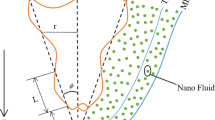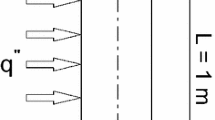Abstract
In this paper two-dimensional incompressible water–Al2O3 nanofluid flow in a confined jet in the laminar flow regime is numerically investigated. A finite volume technique on a collocated grid is employed for discretizing the governing equations by applying the SIMPLE algorithm to link the pressure and velocity fields. The present computations are in a very good agreement with experimental results in open literature.














Similar content being viewed by others
Abbreviations
- AR :
-
Aspect ratio (=h/d)
- c 1, c 2 , c 3 , c 4 :
-
Constant parameter
- c p :
-
Specific heat (kJ/kg K)
- d :
-
Jet length (m)
- d f :
-
Diameter of base fluid molecules (m)
- d p :
-
Average diameter of nanoparticles (m)
- h :
-
Height of channel (m)
- i, j :
-
Indices
- k :
-
Thermal conductivity (W/m K)
- k b :
-
Boltzmann number (=1.3807 × 10−23 J/K)
- l f :
-
Free average distance of water molecules (m)
- N :
-
Parameter for adapting the results with experimental data
- Nu :
-
Nusselt number
- P :
-
Pressure (Pa)
- Pr :
-
Prandtl number of nanofluid
- Q :
-
Heat flux (W/m2)
- Re :
-
Reynolds number
- T :
-
Temperature (K)
- T B :
-
Bulk temperature of nanofluid (K)
- V b :
-
Brownian velocity of nanoparticles (m/s)
- u :
-
Horizontal velocity (m/s)
- v :
-
Vertical velocity (m/s)
- α:
-
Thermal diffusivity (m2/s)
- δ:
-
Center to center distance of nanoparticles (m)
- δ ij :
-
Kronecker delta
- Φ:
-
Volume fraction (%)
- φ:
-
Thermal dissipation
- μ:
-
Viscosity (Pa s)
- ρ:
-
Density (kg/m3)
- τ:
-
Stress tensor (Pa)
- avg :
-
Average
- f :
-
Base fluid
- in :
-
Inlet
- nf :
-
Nanofluid
- p :
-
Particle
- w :
-
Wall
References
Choi SUS (1995) Enhancing thermal conductivity of fluids with nanoparticles. In: Siginer DA, Wang HP (eds) Developments and applications of non-Newtonian flows, vol 231/MD 66. ASME, New York, pp 99–103
Keblinski P, Phillpot SR, Choi SUS, Eastman JA (2002) Mechanisms of heat flow in suspensions of nano-sized particles (nanofluid). Int J Heat Mass Transf 45:855–863
Eastman JA, Phillpot SR, Choi SUS, Keblinski P (2004) Thermal transport in nanofluids. Annu Rev Mater Res 34:219–246
Li CY, Garimella SV (2001) Prandtl-number effects and generalized correlation confined and submerged jet impingement. Int J Heat Mass Transf 44:3471–3480
Garimella SV (2000) Heat transfer and flow fields in confined jet impingement. Annu Rev Heat Transf 11:413–494
Narumanchi SVJ, Hassani V, Bharathan D (2005) Modeling single-phase and boiling liquid jet impingement cooling in power electronics. Technical report NREL/TP-540-38787 December
Sarma ASR, Sundararajan T, Ramjee V (2000) Numerical simulation of confined laminar jet flows. Int J Numer Meth Fluids 33:609–626
Biswas G, Breuer M, Durst F (2004) Backward-facing step flows for various expansion ratios at low and moderate Reynolds numbers. ASME J Fluids Eng 126:362–374
Kanna PR, Das MK (2005) Conjugate forced convection heat transfer from a flat plate by laminar plane wall jet flow. Int J Heat Mass Transf 482:896–2910
Battaglia F, Tavener SJ, Kulkarni AK, Merkle CL (1997) Bifurcation of low Reynolds number flows in symmetric channels. AIAA J 35:99–105
Fearn RM, Mullin T, Cliffe KA (1990) Non-linear flow phenomena in a symmetric sudden expansion. J Fluid Mech 211:595–608
Durst F, Melling A, Whitelaw JH (1974) Low Reynolds number flow over a plane symmetric sudden expansion. J Fluid Mech 64:111–128
Cherdron W, Durst F, Whitelaw JH (1978) Asymmetric flows and instabilities in symmetric ducts with sudden expansions. J Fluid Mech 84:13–31
Ouwa Y, Watanabe M, Asawo H (1981) Flow visualization of a two-dimensional water jet in a rectangular channel. Jpn J Appl Phys 20:243–247
Shuja SZ, Yilbas B, Ma S, Khan S (2008) Jet emerging from an annular nozzle and impinging onto cylindrical cavity: effect of jet velocity on flow structure and heat transfer rates. Proc I Mech E Part C J Mech Eng Sci 222:1021–1031
Baydar E, Ozmen Y (2006) An experimental investigation on flow structures of confined and unconfined impinging air jets. Heat Mass Transf 42:338–346
Celik N (2011) Effects of the surface roughness on heat transfer of perpendicularly impinging co-axial jet. Heat Mass Transf 47:1209–1217
Manca O, Mesolella P, Nardini S, Ricci D (2011) Numerical study of a confined slot impinging jet with nanofluids. Nanoscale Res Lett 6:188–204
Al-Aswadi AA, Mohammed HA, Shuaib NH, Campo A (2010) Laminar forced convection flow over a backward facing step using nanofluids. Int Commun Heat Mass Transf 37:950–957
Gherasim I, Roy G, Nguyen CT, Vo-Ngoc D (2011) Heat transfer enhancement and pumping power in confined radial flows using nanoparticle suspensions (nanofluids). Int J Therm Sci 50:369–377
Ghazvini M, Akhavan-Behabadi MA, Esmaeili M (2009) The effect of viscous dissipation on laminar nanofluid flow in a microchannel heat sink. Proc I Mech E Part C J Mech Eng Sci 223:2697–2706
Chon CH, Kihm KD, Lee SP, Choi SUS (2005) Empirical correlation finding the role of temperature and particle size for nanofluid (Al2O3) thermal conductivity enhancement. Appl Phys Lett 87:153107–153110
Mintsa HA, Roy G, Nguyen CT, Doucet D (2009) New temperature dependent thermal conductivity data for water-based nanofluids. Int J Therm Sci 48:363–371
Masoumi N, Sohrabi AN, Behzadmehr A (2009) New model for calculating the effective viscosity of nanofluids. J Phys D Appl Phys 42:055501–055506
Pak BC, Cho YI (1998) Hydrodynamic and heat transfer study of dispersed fluids with submicron metallic oxide particles. Exp Heat Transf 11:151–170
Author information
Authors and Affiliations
Corresponding author
Rights and permissions
About this article
Cite this article
Rahimi-Esbo, M., Ranjbar, A.A., Ramiar, A. et al. Numerical simulation of forced convection of nanofluid in a confined jet. Heat Mass Transfer 48, 1995–2005 (2012). https://doi.org/10.1007/s00231-012-1040-8
Received:
Accepted:
Published:
Issue Date:
DOI: https://doi.org/10.1007/s00231-012-1040-8




